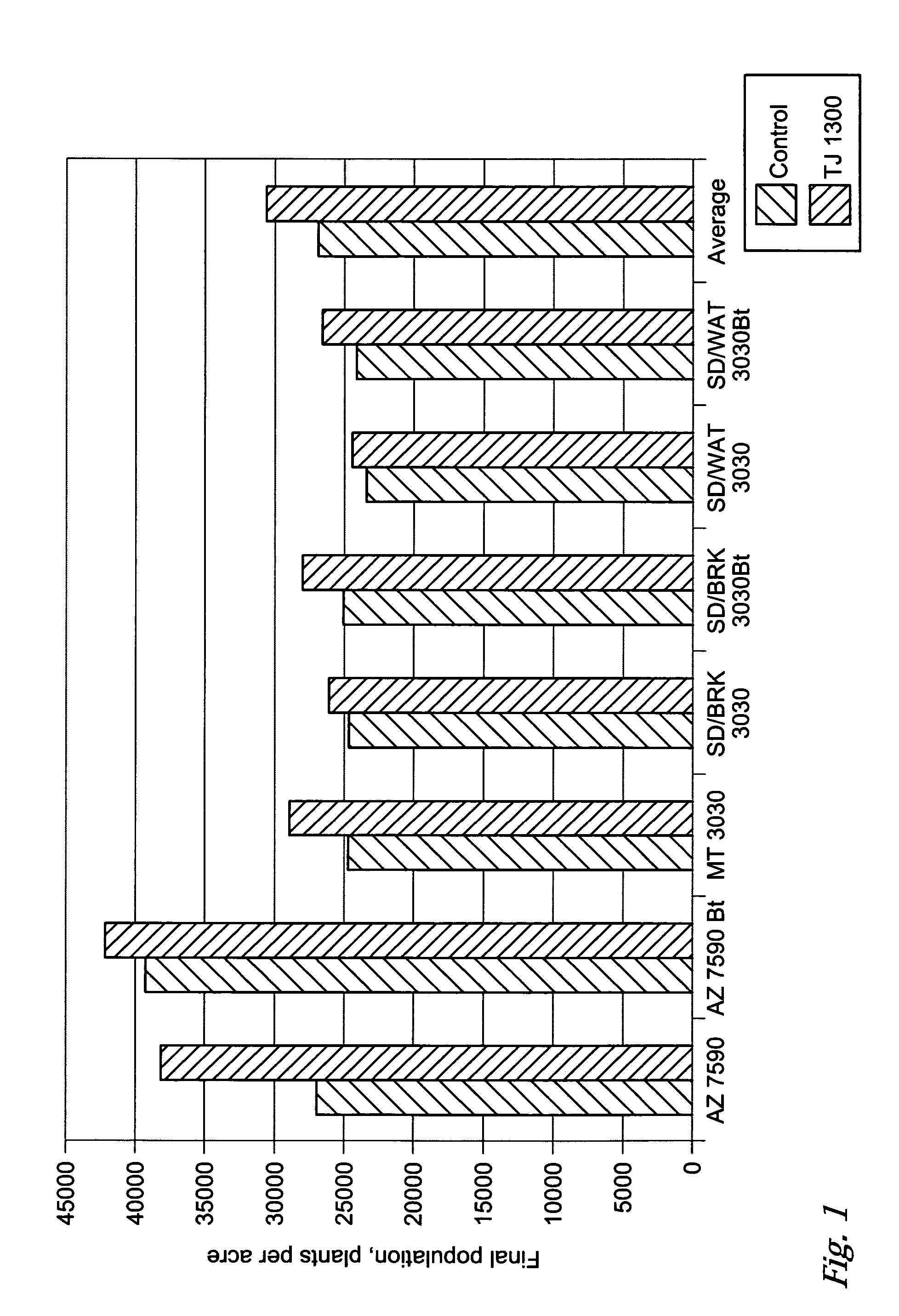Controlling plant pathogens with bacterial/fungal antagonist combinations
a technology of fungicide and plant pathogen, which is applied in the field of fungal/bacterial antagonist combination, can solve the problems of low yield of hybrids, no chemical or biological fungicide available, and loss of crops, and achieves the effects of extending shelf life, effective control, and increasing economic control of root and stalk ro
- Summary
- Abstract
- Description
- Claims
- Application Information
AI Technical Summary
Benefits of technology
Problems solved by technology
Method used
Image
Examples
first greenhouse working example
[0140]Greenhouse testing was conducted to determine the effectiveness of the disclosed biocontrol agents. Treated and untreated corn seeds were grown in soil infested with seven percent Fusarium infested wheat seed. In this testing, the following treatment codes were used:
[0141]CONTROL—Nothing on the seed
[0142]TJ 1000—Bacillus amyloliquefaciens TJ 1000 or 1 BE
[0143]TJ 0300—Trichoderma virens G1-3
[0144]TJ 1300—50 / 50 combination of Trichoderma virens G1-3 and Bacillus amyloliquefaciens TJ1000 or 1BE
[0145]TJ 1310—competitive culture of Trichoderma virens G 1-3 and Bacillus amyloliquefaciens TJ1000 or 1BE, resulting in a 70 / 30 ratio of Trichoderma to Bacillus
[0146]The results of greenhouse testing are presented in Table 0. The rating scale used was 9=worst plant protection and 1=best plant protection. Seed treated with biocontrol organisms grown in competitive culture showed an increase in plant protection over seed treatments with the same biological control organisms grown in non-com...
second greenhouse working example
[0153]Greenhouse Methods: All test cultures were grown in MYE (three percent Molasses, 0.5 percent Yeast Extract) broth for five days. Bacteria were grown up individually (non-competitive) and with T. virens G1-3 (competitive culture). T. virens G1-3 was also grown in a non-competitive culture for testing. T. virens G1-3 and test bacteria grown in non-competitive culture were also applied to the same seed to test the effectiveness of non-competitive culture versus competitive culture. Corn seeds were treated to give a final concentration of 1×109 bacteria / fungal spores (may also be referred to a Colony Forming Units or CFU) per acre. Seed treatment was done with a Gustafson Benchtop Seed Treater, Model BLT. Seeds were grown in soil infested with seven percent Fusarium-infested wheat seed. After four weeks, plant heights were taken as well as plant biomass. Plant heights were taken by measuring from the soil line to the tallest leaf, biomass of the plants was taken by cutting the pla...
trial working example
Combinations Field Trial Working Example
[0168]Materials and Methods: A field trial was conducted using the corn variety NK 3030Bt using the following biological treatments of the seed at a rate of approximately 106 CFU per seed. The seed was planted at a seeding rate of 25,000 seeds per acre in 30-inch rows in a randomized, replicated block. Each entry was replicated four times. The pathogen levels were natural populations at a location near Groton, S.Dak. The entries were as follows:
[0169]Control: Maxim Seed treatment (Maxim is a trademark of Syngenta Crop Protection)
[0170]TJ 1000—Bacillus amyloliquefaciens TJ1000 or 1BE
[0171]TJ 0300—Trichoderma virens G1-3
[0172]TJ 1300—50 / 50 combination of B. amyloliquefaciens TJ1000 or 1BE and T. virens G1-3
[0173]TJ 1310—Coculture 30 / 70 combination of B. amyloliquefaciens TJ 1000 or 1 BE and T. virens G1-3
[0174]TJ 66 / 300—50 / 50 combination of Bacillus lentimorbus and T. virens G1-3
[0175]Results: The trial produced significant yield response over t...
PUM
| Property | Measurement | Unit |
|---|---|---|
| temperature | aaaaa | aaaaa |
| pressure | aaaaa | aaaaa |
| composition | aaaaa | aaaaa |
Abstract
Description
Claims
Application Information
 Login to View More
Login to View More - R&D
- Intellectual Property
- Life Sciences
- Materials
- Tech Scout
- Unparalleled Data Quality
- Higher Quality Content
- 60% Fewer Hallucinations
Browse by: Latest US Patents, China's latest patents, Technical Efficacy Thesaurus, Application Domain, Technology Topic, Popular Technical Reports.
© 2025 PatSnap. All rights reserved.Legal|Privacy policy|Modern Slavery Act Transparency Statement|Sitemap|About US| Contact US: help@patsnap.com



